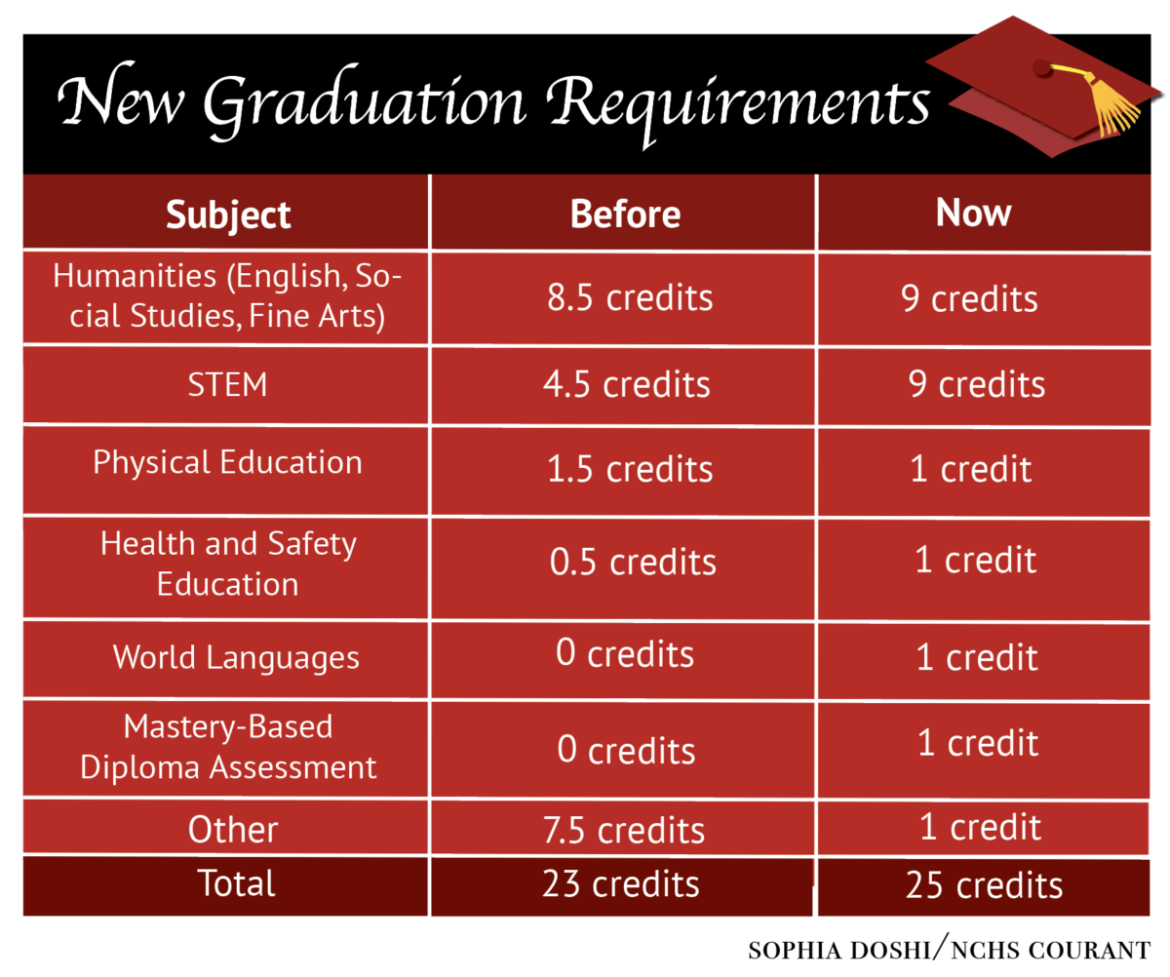Ava Fonss, News Editor
@afonsscourant
During the second semester, juniors will begin creating a ‘Mastery-Based Diploma Assessment’ in accordance with Connecticut’s graduation requirements for the class of 2023. In addition to completing a portfolio that includes and reflects on work completed over the past few years, students must also fulfill updated course requirements in order to graduate. These requirements have been in place for the class of 2023 since the start of the 2019-2020 school year.
Connecticut’s Public Act No. 17-42, passed in 2017 by the General Assembly, changes the number and distribution of credits required to receive a diploma from a Connecticut high school. Beginning with the current junior class, students must now accumulate a minimum of 25 credits prior to graduation, rather than the previously-required 23. These 25 credits fit into requirements for several different categories which include humanities, STEM, health, and world language. One credit will be fulfilled by the Mastery-Based Diploma Assessment. The assessment will allow each student to reflect upon work that they completed throughout their high school career by collecting three pieces of work into a portfolio and completing a reflection.
The law aims to increase the value of a Connecticut high school diploma. “The new requirements force a lot more for everyone, especially in the STEM field,” Assistant Principal Ari Rothman said. “When you set requirements at a state level, you’re setting an expectation for all students in a state. The idea is to make a diploma from a Connecticut high school reflect a more rigorous education.”
For the new Mastery-Based Diploma Assessment, students will reflect upon work that they completed over the past few years. “The idea is for you to pull from all the work you’ve done in any subject area that you were strongest in, or whatever has challenged you,” Mr. Rothman said. “You’ll choose those pieces and then write a reflection on what you learned and how those pieces impacted your learning as you went through high school.”
According to School Counseling Department Chair Cynthia Rivera, there has been very little direction from the state in terms of the type of work required except for that the Mastery-Based Diploma Assessment needs to consist of items that encompass work done over four years. “We assume that most students have been keeping papers, writing portfolios, science labs, or other related projects over the past few years,” she said. “Some kids might want to include a musical performance or an artistic project that they are proud of.”
Social Studies Department Chair Robert Stevenson and English Language Arts Department Chair Evan Remley both worked to create the school-specific guidelines for the Mastery-Based Diploma Assessment. These guidelines were discussed in a November 1 Board of Education meeting. “The key piece is that students will be writing a reflection where they talk about their growth as a learner,” Mr. Stevenson said. “Those reflections will be evaluated by an interdisciplinary team of teachers with the support of the writing center.” According to Mr. Stevenson, students will be able to choose from a wide range of pieces to include.
Mr. Remley also expects teachers to use the Mastery-Based Diploma Assessment as a tool. “It’s very important for teachers to evaluate student artifacts and learn from them,” he said. “They can tell you a lot about your instruction and open up pathways for more interdisciplinary work and project-based learning.”
Currently, many students have limited knowledge about the Mastery-Based Diploma assessment. “This portfolio has not been talked about a lot, so I don’t know much about what needs to be included or what is recommended to be included,” Junior Jamie Leahy said. “When I begin putting it together, I’m expecting to include projects and papers from the classes I’ve taken over the years.”
Students will begin working on the Mastery-Based Diploma Assessment in the second half of their junior year. “Getting more familiar with the reflective process will help students when they eventually begin to create their college essay,” Ms. Rivera said. “Students who don’t meet the reflection standard will be provided with one-on-one assistance.”
According to Mr. Rothman, these new requirements will not significantly impact a student’s ability to graduate. “A school like ours is not significantly affected because the vast majority of our students already took the classes required to meet our own graduation requirements,” he said. “In the past, we’ve already seen many students getting more than the 23 credits that were previously required.”
As reported by the 21-22 School Profile, 95% of students in the class of 2021 chose to enroll in a four-year college. This college-oriented mindset has limited the effect of the new requirements. “The expectation, which isn’t changing quickly, is that a student who wants to be considered seriously for college already has four years in each of the core subjects as well as a minimum of three years of a language,” Mr. Rothman said. “I don’t think students have to consciously change anything.”
Ms. Rivera had similar ideas. “There’s been a shift in not just ticking off boxes but getting students to stop and reflect on their learning and to raise the bar a little,” she said. “I don’t think it has much to do with schools like ours since we have such a high bar already.”
In 9th grade, counselors meet with students to create a four-year plan which ensures that students meet all requirements by the time they graduate. In March, counselors discuss scheduling for the following year. “It’s really the counselors who work with the students to ensure that each student meets the requirements,” Ms. Rivera said.
Although taking a World language has not been required in past years, the new law states that students must now fulfill one world language credit in order to graduate. “In the diverse world that we live in, the state felt that it was important to require at least one year,” Ms. Rivera said. “Most of our students generally complete at least one year of language already.”
Jamie sees the importance of implementing this requirement. “I think that foreign language is definitely an important skill to have, no matter what career you pursue after high school,” she said. “I’m definitely not opposed to the one credit for foreign language, and I think it’s definitely something that should be encouraged.” According to Jamie, she has had meetings with her counselor to discuss the different classes and credits needed to graduate since her freshman year.
Since the introduction of the new requirements, the administration has been implementing ways to make fulfilling all necessary credits easier for students. “We’ve done some cross-referencing in regards to the kind of credits that can be received for certain courses,” Ms. Rivera said. “We’re putting this information in the Program of Studies so students can understand where they can cross-reference things”. According to Ms. Rivera, although Economics usually counts for a humanities credit, it can also be counted as a STEM class due to its math-oriented nature.
According to Mr. Rothman, new programs have also been developed so that every student has the ability to get at least 25 credits. “The world language department has created some different courses that are a little more accessible,” he said. “It’s the school’s responsibility to make sure that there’s enough variety of courses and appropriate cross-indexing to enable every single student a means to achieve a diploma.”




